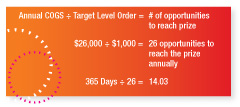Time management for the inventory investor
Setting proper review cycles can improve your ROI
by Jason Bader
What percentage of your current distribution management software package do you actually use? Most distributors use about 20% of the capacity of their systems. Occasionally, I run across the power user at a whopping 35% utilization. My next question is, "What percentage of the package did you actually pay for?" How's that for a swift kick to the gut?
The antidote for this poor return on investment is product knowledge. Not product knowledge in the traditional sense of knowing what you sell. Instead, I am talking about taking time to get to know the software you bought.
Contrary to popular belief, most inventory management modules in distribution software packages are well designed. Used properly, your inventory investors will be able to keep tabs on the movement of thousands of different SKUs.
In this article, I want to talk about a field in the item record that continues to baffle many inventory management professionals. The review cycle is one of those little gems that so many people tend to overlook and ultimately leave at the default setting. Let's face it. When we went live, the last thing we were thinking about was, "Man, I need to make sure that review cycle is set properly." It is a shame that most people haven't learned to leverage the power of this field. This is time management for the inventory investor.
How often do you review a supplier line? Is it monthly? Weekly? Daily? I know companies that review every supplier daily – on paper no less. Talk about killing trees. Several distributors set up a review schedule based on weeks. They do it this way because that is the way they were taught. Some base the review on the lead time. If they have an average lead time of 30 days, they review every 30 days. Unfortunately, they are missing the power of proper timing.
In a line-buy methodology, the review cycle creates a window in time where we can accumulate enough requirements to meet a vendor prize. The most common vendor prize is free freight. My friends in the logistics business would argue there is no such thing as free freight, but for this discussion, let's remain blissfully ignorant. When a vendor offers free freight at a specific dollar amount, this becomes our recommended order size. You will often find a field in the vendor record called "target level order." During the vendor set up, you typically populate this with the amount of money required to receive the prize.
Free freight is not the only vendor prize out there. There may be discounts available for placing orders of a certain size. There may be rebates involved with placing certain size orders. These dollar amounts would populate the target level order field. Dollars are not the only unit of measure. Sometimes suppliers base the prize on placing orders of a certain weight or the ability to fill a container. These are all factors in determining the optimum time to place an order.
The review cycle is designed to help us take advantage of the prize as many times as possible in a year. Do we always hit that target on multiples of seven? This is the assumption if we review lines once a week or bi-weekly. In order to determine how many days to set the review cycle, we need to do a little math. For this example, let's say we have $26,000 in annual cost of goods sold (COGS) with a supplier. The vendor has a freight prepaid of $1,000. Where should we set the review cycle to take maximum advantage of the prize?
 In this example, we should set the review cycle at 14 days. In practical terms, when we run the replenishment requirements for this supplier every 14 days, we should have accumulated enough items to meet the $1,000 freight prepaid. If our annual cost of goods sold was higher, the review cycle would be shorter. Perhaps we could reach the prize in 10 days. If we were still working on the weekly buying schedule, we would be short of the prize. Conversely, if we waited until two weeks passed to accumulate requirements, our requirements would be greater than the prize. Not the kiss of death, but we wouldn't be maximizing the incentive from our supplier.
In this example, we should set the review cycle at 14 days. In practical terms, when we run the replenishment requirements for this supplier every 14 days, we should have accumulated enough items to meet the $1,000 freight prepaid. If our annual cost of goods sold was higher, the review cycle would be shorter. Perhaps we could reach the prize in 10 days. If we were still working on the weekly buying schedule, we would be short of the prize. Conversely, if we waited until two weeks passed to accumulate requirements, our requirements would be greater than the prize. Not the kiss of death, but we wouldn't be maximizing the incentive from our supplier.
Looking at the previous year is not always the best crystal ball. Sales trends change from year to year. If you are looking at an upward trend this year, subtract a day or two from the review cycle. If sales are slowing, add a day or two. Making adjustments throughout the year is prudent inventory investing.
I think you are getting the picture about the financial benefits of setting proper review cycles, but what about the time management aspects? In my experience, most companies review suppliers far too frequently. I know several distributors who feel they need that daily look. How much time do we waste pouring over replenishment reports to say, "Looks like we aren't there yet, maybe tomorrow . . ."? I would rather redirect my inventory investors to spend time analyzing ways to get a better return on investment.
Consider this scenario. What if our annual cost of goods sold in the previous example was $260,000 vs. $26,000 and the freight prepaid was $250. We can hit the prize three times per day. Theoretically, we should run the replenishment report three times a day. This defeats our time management agenda, doesn't it? In this case, I would generally put my review cycle at somewhere around three to five days. But we shouldn't overlook an opportunity here.
If you can grossly exceed the offered prize by a supplier, why can't you negotiate something better? In the above example, I could easily put together orders of $5,000
in a week. Is there a cost savings realized by the supplier when I place a larger order? Absolutely. Is there any reason that we should not participate in this cost savings? None that I can think of.
As margins squeeze, we are all looking for ways to find a nickel, dime or quarter in the operating expenses. I challenge you to take a look at how frequently you are reviewing your replenishment reports. Setting proper review cycles can give your inventory investors the time to discover a better return on your purchasing dollar.
Good luck.
 Jason Bader, managing partner of The Distribution Team, spent the first 20 years of his career working in distributor operations. His firm specializes in helping distributors become more profitable through operating efficiencies. He can be reached at (503) 282-2333 or jason@distributionteam.com or www.thedistributionteam.com.
Jason Bader, managing partner of The Distribution Team, spent the first 20 years of his career working in distributor operations. His firm specializes in helping distributors become more profitable through operating efficiencies. He can be reached at (503) 282-2333 or jason@distributionteam.com or www.thedistributionteam.com.
This article originally appeared in the May/June 2010 issue of Industrial Supply magazine. Copyright 2010, Direct Business Media.













